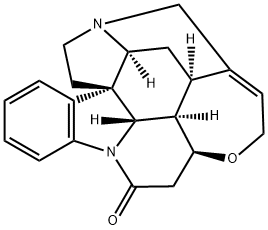CHEMICAL AND PHYSICAL PROPERTIES
| Physical Description | Strychnine appears as colorless, transparent crystals or white crystalline powder. Has no odor. Used for destroying rodents and predatory animals and for trapping fur-bearing animals. (EPA, 1998) |
|---|---|
| Color/Form | Brilliant, colorless cubes from chloroform-ether |
| Odor | Odorless |
| Taste | Very bitter metallic taste |
| Boiling Point | 518 °F at 5 mmHg (EPA, 1998) |
| Melting Point | 514 to 554 °F (EPA, 1998) |
| Solubility | 0.02 % (NIOSH, 2023) |
| Density | 1.36 at 68 °F (EPA, 1998) - Denser than water; will sink |
| Vapor Pressure | Low (NIOSH, 2023) |
| LogP | log Kow = 1.93 |
| Stability/Shelf Life | Stable under recommended storage conditions. |
| Optical Rotation | Specific optical rotation: -139 deg at 18 °C/D (c = 0.4 in chloroform); -104.3 deg at 20 °C/D (c = 0.254 in alcohol) |
| Decomposition | Hazardous decomposition products formed under fire conditions - Carbon oxides, nitrogen oxides (NOx). |
| Heat of Combustion | 2,685.7 kg/cal at 20 °C (solid) |
| pH | pH 9.5, saturated solution |
| Ionization Efficiency | Positive |
| Odor Threshold | Detection thresholds: 1.60 x 10(-6) mol/L water; 6.0 x 10(-4) mg/L water; 4.0 x 10(-4) g/L water /Strychnine hydrochloride/ |
| Dissociation Constants | pKa= 8.26 at 25 °C |
| Collision Cross Section | 172 Ų [M+H]+ [CCS Type: TW, Method: Major Mix IMS/Tof Calibration Kit (Waters)] |
| Other Experimental Properties | Efflorescent, trimetric prisms. One gram dissolves in ~35 mL water, ~80 mL alcohol. Insoluble in ether. pH of 0.01M solution 5.4 /Strychnine hydrochloride dihydrate/ |
| Chemical Classes | Biological Agents -> Plant Toxins |
SAFETY INFORMATION
| Signal word | Danger |
|---|---|
| Pictogram(s) |
 Skull and Crossbones Acute Toxicity GHS06  Environment GHS09 |
| GHS Hazard Statements |
H410:Hazardous to the aquatic environment, long-term hazard |
| Precautionary Statement Codes |
P262:Do not get in eyes, on skin, or on clothing. P264:Wash hands thoroughly after handling. P264:Wash skin thouroughly after handling. P273:Avoid release to the environment. P280:Wear protective gloves/protective clothing/eye protection/face protection. P301+P310:IF SWALLOWED: Immediately call a POISON CENTER or doctor/physician. |
COMPUTED DESCRIPTORS
| Molecular Weight | 334.4 g/mol |
|---|---|
| XLogP3 | 1.9 |
| Hydrogen Bond Donor Count | 0 |
| Hydrogen Bond Acceptor Count | 3 |
| Rotatable Bond Count | 0 |
| Exact Mass | 334.168127949 g/mol |
| Monoisotopic Mass | 334.168127949 g/mol |
| Topological Polar Surface Area | 32.8 Ų |
| Heavy Atom Count | 25 |
| Formal Charge | 0 |
| Complexity | 689 |
| Isotope Atom Count | 0 |
| Defined Atom Stereocenter Count | 6 |
| Undefined Atom Stereocenter Count | 0 |
| Defined Bond Stereocenter Count | 0 |
| Undefined Bond Stereocenter Count | 0 |
| Covalently-Bonded Unit Count | 1 |
| Compound Is Canonicalized | Yes |
PRODUCT INTRODUCTION
description
Strychnine appears as colorless, transparent crystals or white crystalline powder. Has no odor. Used for destroying rodents and predatory animals and for trapping fur-bearing animals. (EPA, 1998)
